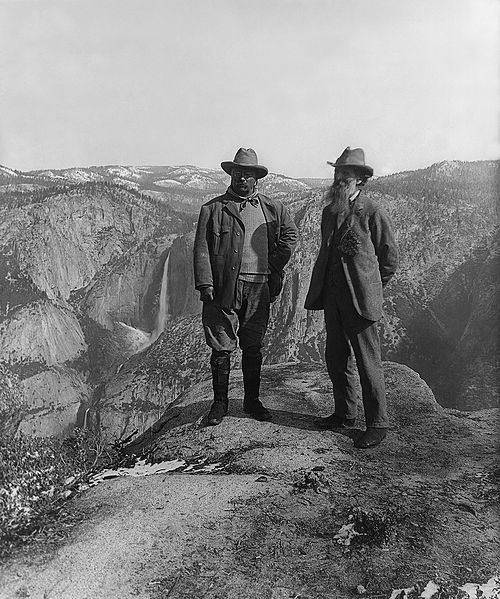 |
| Nature preservationist John Muir with US President Theodore Roosevelt (left) on Glacier Point in Yosemite National Park |
New conceptions of how humans should interact with the natural world put down roots in 19th-century America. Aristocratic Europe's pastoral perspective valued neatly kept farms and artfully landscaped vistas. Some Americans had different views.
Mid-19thcentury Massachusetts transcendentalist Henry David Thoreau studied natural processes and experimented with a new kind of natural simplicity at Walden Pond, bemoaning the noisy incursion of trains. Gaining influence after his death in 1862, Thoreau fathered what eventually became an environmental movement.
By the first half of the 20th century, a growing U.S. conservation movement had saved some of the nation's most spectacular natural landscapes. In 1872 President Ulysses S. Grant and Congress created Yellowstone National Park in Montana and Wyoming, officially described as "a pleasuring-ground for the benefit and enjoyment of the people." Grant was first in a series of presidents to protect certain lands from most kinds of human exploitation. Many individual states mounted smaller parks projects.
  |
By 1890, when the U.S. census revealed that America's frontier—its stock of unclaimed land—had virtually disappeared, rescuing remaining natural treasures took on new urgency. California's Yosemite became a national park in 1890.
Taking office in 1901, Theodore Roosevelt, an outdoorsman himself, initiated conservation programs that truly reshaped the nation. During his progressive presidency, Arizona's Grand Canyon and four other national parks were established.
Advised by forester Gifford Pinchot, Roosevelt set aside more than 231,000 square miles of forested land and established the National Forest Service. His 1906 Antiquities Act helped to identify and preserve prehistoric and historic sites of special significance, including some Indian structures and major Civil War battlefields.
President William Howard Taft in 1910 created Montana's 1,600-square-mile Glacier National Park, long the dream of Forest and Stream editor George Bird Grinnell. But later that year a controversy between Taft and Pinchot over the proper use of forest set-asides led to Pinchot's firing and became a factor in Roosevelt's "Bull Moose" campaign against Taft in 1912.
Their political feud revealed some of the difficulties and ironies of a nation legislating "wilderness" and scenic beauty. Especially in the American West, where the federal government owned a large percentage of the land, many interests clamored for greater commercial and personal access.
Was providing seemingly untouched natural beauty to awed urban visitors really more important than a rancher, miner, or farmer making a decent living? Conservationists were often a minority in these local and regional arguments, although railroad interests often supported conservation projects that enhanced tourist travel by train.
Additionally, although this would hardly have bothered most white people at that time, many conservation, preservation, and set-aside programs effectively severed Native American tribes from their traditional uses of Yellowstone, Yosemite, Glacier, and other new American shrines. What conservationists worshipped as "virgin land" or "wilderness" had in many cases been used by Indians for centuries as habitat and hunting and fishing grounds.
Conservation leaders like Scots-born John Muir, a founder in 1892 of the Sierra Club, and Iowa native Aldo Leopold, cofounder in 1935 of the Wilderness Society, were naturalists who were primarily interested in protecting the natural environment as much as possible from human disturbance. Although they and their many allies worked closely with government agencies, there was a constant struggle over how protected lands could be used.
Mining, grazing, farming, and timbering rights in park reserves were clearly a source of tension. So too was the very purpose of a growing national parks system—to expose large numbers of human visitors to "nature." Tourism also could, and certainly would, endanger truly wild places.
Teddy Roosevelt once spent four days in Yosemite with Muir camping and hiking, but that did not mean that conservationists always had the ear of politicians. President Woodrow Wilson, who in 1916 authorized creation of the National Park Service, had three years earlier accepted congressional approval of the Hetch-Hetchy dam that flooded part of Yosemite in order to provide San Francisco with drinking water. It was a bitter defeat for the Sierra Club and Muir's last great wilderness crusade.
In 1907 Pinchot had defined conservation as "the use of the Earth for the good of Man." By the 1930s the New Deal was siting and building huge dams for travel, irrigation, and hydroelectric power across the American landscape.
Especially in Appalachia, site of the Tennessee Valley Authority (TVA) and along the Columbia River in the Pacific Northwest, these dams permanently reshaped ancient landscapes and affected fish and wildlife, usually for the worse. In this same era President Franklin D. Roosevelt's young men's work initiative, the Civilian Conservation Corps, was a boon for neglected or underfunded national parks.
Trails were cut, scenic overlooks created, and benches and tourist facilities provided or improved. But when the economy recovered, this meant that even more people could easily leave their own imprint on the landscape.
Starting his career with the Forest Service in 1909, Aldo Leopold came to believe that managing forested areas was not the same as protecting trees and their ecosystem. Leopold and others began to believe that nature's "rights" should and sometimes must trump human needs and desires.
In his influential 1949 book, A Sand County Almanac, published after his death in a fire near his Wisconsin home, Leopold called for a "land ethic" that would encompass respect for "soils, waters, plants and animals."
It was an early intimation of what emerged in the 1960s as a new environmental, or "Green," movement that looked beyond scenery and natural magnificence to the fundamental health of "soils, waters, plants and animals" and humans worldwide.